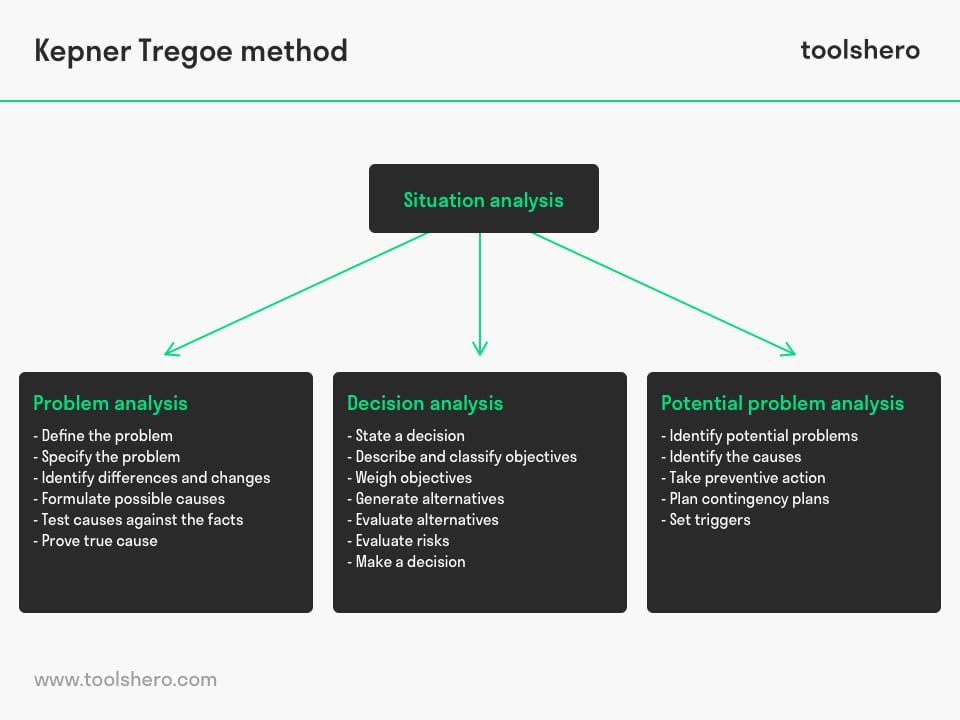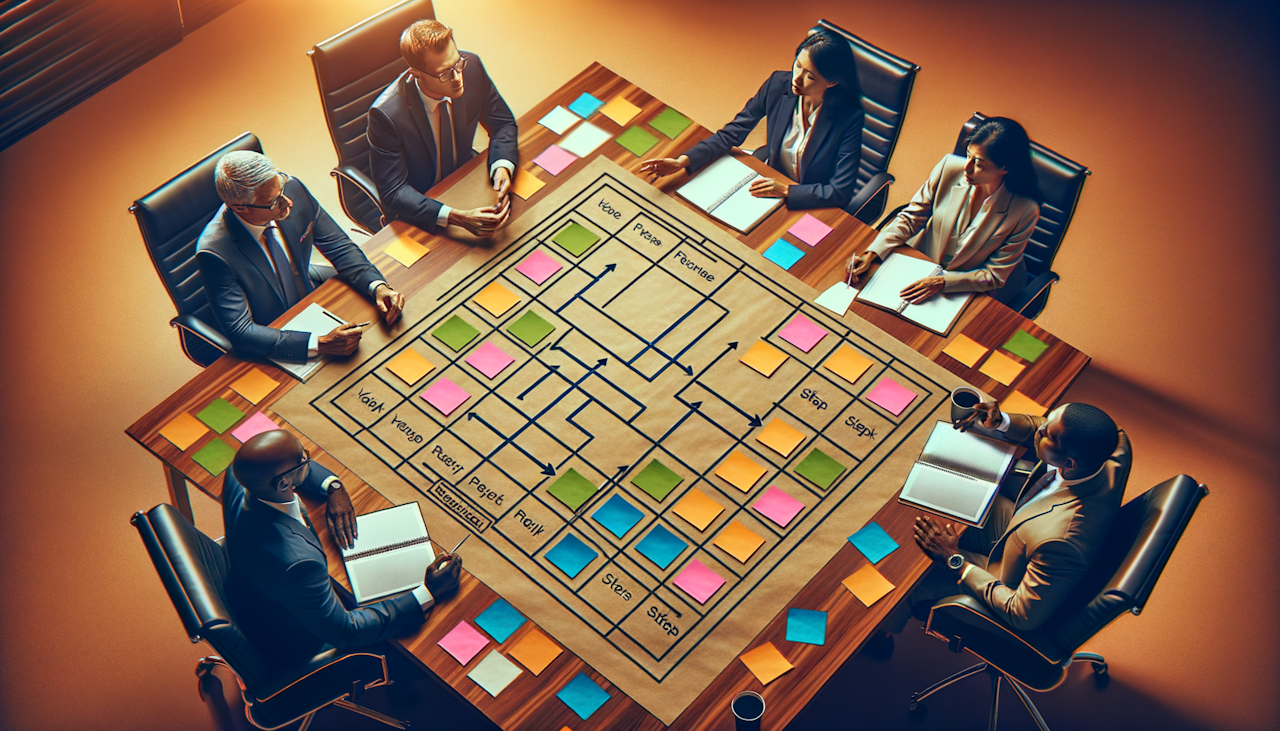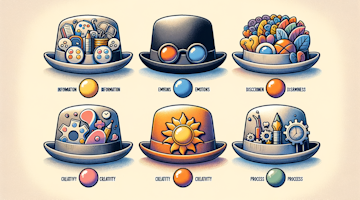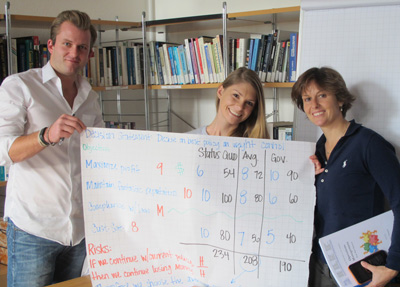- Memberships

Kepner Tregoe Method of Problem Solving

Kepner Tregoe Method of Problem Solving: this article explains the Kepner Tregoe Method , also known as the KT-method , developed by Charles Kepner and Benjamin Tregoe in a practical way. Next to what this is, this article also highlights rational processes, the importance of cause and that this method is effective. After reading, you’ll have a basic understanding of this problem solving process. Enjoy reading!
What is the Kepner Tregoe Method?
Problems occur in any given organization. Often there is pressure of time to solve the problems and it is debatable what the right way of solving these problems is.
The Kepner Tregoe method or KT-method is a problem analysis model in which the “problem” is disconnected from the “decision” . An English synonym for this problem solving method is Problem Solving and Decision Making (PSDM).

Traditional thinking pattern
The founders Charles Kepner and Benjamin Tregoe developed a rational working method in the 1960s in which they researched and identified the troubleshooting skills of people.
Throughout the centuries mankind has learned to deal with complexity and to (directly) anticipate on this. As a consequence, the traditional thinking pattern became a part of human nature.
When solving problems people search for the answer to the following four questions:
- What happened?
- Why did it happen?
- How should we act?
- What will be the (future) result?
Kepner Tregoe method: rational processes
To break through this traditional pattern Charles Kepner and Benjamin Tregoe came up with four rational processes in which four fundamental questions are reflected:
1. Situation analysis
This clarifies the problem situation (what happened).
1.1 Problem analysis
Here the actual cause of the problem and the relationship between cause and result are searched for (why did it happen).
1.2 Decision analysis
Based on the decision making criteria, choices are made to arrive at potential problem resolutions (how should we act).
1.3 Potential Problem analysis

Figure 1 – Kepner Tregoe Method Analysis
Distinction
According to the KT-method, different tasks involve different problems, which in turn need different approaches. A situation analysis will clarify the distinctions in all these processes and as a result it will be possible to search for suitable solutions. This situation analysis provides an insight into necessity, priority and urgency of the various tasks.
When it has become clear which tasks are to be prioritized (action list) preparations can be made for potential problems. By using a good problem analysis in advance, a process will be created to prevent future problems or in emergencies, to limit the damage.
The strengths of this method does not stop there. Apart from the fact that problems are specified in terms such as “what, where, when and how big”, the Kepner Tregoe Method focuses on anything that cannot be the cause of the problem.
Certain causes are therefore excluded. Based on a “this is” and “this is not” analysis a clear overview of possible causes can be created and this makes the troubleshooting process consistent.
The Kepner Tregoe Method is efficient
The KT-method deploys an efficient troubleshooting process. Through research Charles Kepner and Benjamin Tregoe discovered that the registration of a problem is not a uniform process. In spite of the available information, people usually process information badly, misinterpret this or overlook important matters.
In addition, Charles Kepner and Benjamin Tregoe examined the discrepancies between successful and less successful troubleshooting.
They discovered that a predetermined logical method facilitates the search for the causes of a problem. In their “Best practice in troubleshooting” , they describe this methodology, which forms the basis for this method.
The Kepner Tregoe Method is Effective
This method is universal and is still used today in many organizations to track down problems and identify potential causes. Apart from the fact that the Kepner Tregoe Method leads to an explanation of problems, it also helps improve mutual understanding within an organization.

It’s Your Turn
What do you think? Is the Kepner Tregoe Method applicable in today’s modern organizations? Do you recognize the practical explanation or do you have more suggestions? What are your success factors for the good Kepner Tregoe Method set up?
Share your experience and knowledge in the comments box below.
More information
- Lussier, R. N. (2005). Management fundamentals: concepts. applications, skill development . Cengage Learning .
- Payne, S. L. & Marty, C.S. (1966). The Rational Manager: A Systematic Approach to Problem Solving and Decision Making . Journal of Marketing. Vol. 30 Issue 1, p97.
- Kepner, C. H. & Tregoe, B. B. (1965). The Rational Manager . McGraw-Hill.
How to cite this article: Mulder, P. (2012). Kepner Tregoe Method . Retrieved [insert date] from Toolshero: https://www.toolshero.com/problem-solving/kepner-tregoe-method/
Original publication date: 06/30/2012 | Last update: 12/09/2023
Add a link to this page on your website: <a href=”https://www.toolshero.com/problem-solving/kepner-tregoe-method/”>Toolshero: Kepner Tregoe Method</a>
Did you find this article interesting?
Your rating is more than welcome or share this article via Social media!
Average rating 3.7 / 5. Vote count: 30
No votes so far! Be the first to rate this post.
We are sorry that this post was not useful for you!
Let us improve this post!
Tell us how we can improve this post?

Patty Mulder
Patty Mulder is an Dutch expert on Management Skills, Personal Effectiveness and Business Communication. She is also a Content writer, Business Coach and Company Trainer and lives in the Netherlands (Europe). Note: all her articles are written in Dutch and we translated her articles to English!
Related ARTICLES

Convergent Thinking: the Definition and Theory

CATWOE Analysis: theory and example

Means End Analysis: the basics and example

Systems Thinking: Theory and Definition

5 Whys Root Cause Analysis (Toyoda)

Positive Deviance (PD) explained
Also interesting.

Systematic Inventive Thinking (SIT)

Linear Thinking by Edward De Bono explained

TRIZ Method of Problem Solving explained
4 responses to “kepner tregoe method of problem solving”.
I am stunned to read that the Kepner Tregoe Method “…… IS STILL used today in many organizations to track down problems and identify potential causes…..”. I have used it all the time along my career as a manager of organizations, with extreme success. As a tool for identifying problems, as a tool for taking better decisions. So, please, I would appreciate to know what kind of system is being used now instead of an approach like K-T, to have provoked your comment about the existence of an alternative way of thinking.
Other than KT, I also use the Analytic Hierarchy Process (AHP) Like KT, it forces discipline and analysis and it helps to explain why decisions are made with understandable background and data. Many of the old Total Quality Management tools are also useful for solving problems and making good management decisions. Nominal Group Technique, Pareto Charts, and weighted multivoting are all quite useful. ITIL is the new way of thinking, but it can be rather dry and robotic unless it is underpinned with good decision tools.
Thank you for your comment and sharing your experience Pete.
Seems that I naturally deal with problems this way without knowing a name for it. In fact, it seems obvious to me that this approach should be taken anyway.
Leave a Reply Cancel reply
You must be logged in to post a comment.
BOOST YOUR SKILLS
Toolshero supports people worldwide ( 10+ million visitors from 100+ countries ) to empower themselves through an easily accessible and high-quality learning platform for personal and professional development.
By making access to scientific knowledge simple and affordable, self-development becomes attainable for everyone, including you! Join our learning platform and boost your skills with Toolshero.

POPULAR TOPICS
- Change Management
- Marketing Theories
- Problem Solving Theories
- Psychology Theories
ABOUT TOOLSHERO
- Free Toolshero e-book
- Memberships & Pricing

How it works
For Business
Join Mind Tools
Article • 8 min read
The Kepner-Tregoe Matrix
Making unbiased, risk-assessed decisions.
By the Mind Tools Content Team

No matter what position you hold, from the board room to the mailroom, you make decisions every day.
And the end result in business is directly linked to the quality of the decisions made at each point along the way.
So, not surprisingly, decision-making is a universally important competence in business. Some decisions clearly have a greater impact on the business than others, but the underlying skill is the same: the difference is in the scope and depth of the process you go through to reach your decision.
One reason why decision-making can be so problematic is that the most critical decisions tend to have to be made in the least amount of time. You feel pressured and anxious. The time pressure means taking shortcuts, jumping to conclusions, or relying heavily on instinct to guide your way.
Kepner-Tregoe: Taking the Guesswork out of Decision-Making
In your organization, you've probably heard of someone who made it all the way to VP by relying on his gut to make decisions. At the other extreme is the guy who simply can't make a decision because he analyzes the situation to death. The bottom line is, you have to make decisions, and you have to make good decisions. Poor decisions are bad for business. Worse still, one poor decision can lead to others, and so the impact can be compounded and lead to more and more problems down the line.
Thankfully, decision-making is a skill set that can be learned and improved on. Somewhere between instinct and over-analysis is a logical and practical approach to decision-making that doesn't require endless investigation, but helps you weigh up the options and impacts.
One such approach is called the Kepner-Tregoe Matrix. It provides an efficient, systematic framework for gathering, organizing and evaluating decision-making information. The approach was developed by Charles H. Kepner and Benjamin B. Tregoe in the 1960s and they first wrote about it in the business classic, The Rational Manager (1965). The approach is well-respected and used by many of the world's top organizations including NASA and General Motors. [1]
The Kepner-Tregoe Approach
The Kepner-Tregoe approach is based on the premise that the end goal of any decision is to make the "best possible" choice. This is a critical distinction: the goal is not to make the perfect choice, or the choice that has no defects. So the decision maker must accept some risk. And an important feature of the Kepner-Tregoe Matrix is to help evaluate and mitigate the risks of your decision.
The Kepner-Tregoe Matrix approach guides you through the process of setting objectives, exploring and prioritizing alternatives, exploring the strengths and weaknesses of the top alternatives, and of choosing the final "best" alternative. It then prompts you to generate ways to control the potential problems that will crop up as a consequence of your decision.
This type of detailed problem and risk analysis helps you to make an unbiased decision. By skipping this analysis and relying on gut instinct, your evaluation will be influenced by your preconceived beliefs and prior experience – it's simply human nature. The structure of the Kepner-Tregoe approach limits these conscious and unconscious biases as much as possible.
The Kepner-Tregoe Matrix comprises four basic steps:
- Situation Appraisal – identify concerns and outline the priorities.
- Problem Analysis – describe the exact problem or issue by identifying and evaluating the causes.
- Decision Analysis – identify and evaluate alternatives by performing a risk analysis for each and then make a final decision.
- Potential Problem Analysis – evaluate the final decision for risk and identify the contingencies and preventive actions necessary to minimize that risk.
Going through each stage of this process will help you come to the "best possible choice", given your knowledge and understanding of the issues that bear on the decision.
How to Use the Tool
The Kepner-Tregoe Matrix is an in-depth approach that can be supported by detailed instruction and worksheets. As an overview of the approach, the following steps show the general principles of how the Kepner-Tregoe approach can apply to a decision-making situation:
1. Prepare a decision statement.
- This is a general overview of what the decision is expected to achieve (the key objective).
- The statement should discuss the action that is required and the result that is desired.
2. Establish strategic requirements ("Must Haves").
- What "musts" will the final decision provide, allow for, include, etc.? For example: we must have 10 percent cost saving, we must include four color choices, the rope must hold 200 lbs.
- These requirements are absolute – there is no compromise.
3. Establish operational objectives ("Want to Haves").
- What do you "want" the final decision to support?
- By identifying the wants you can rank the alternatives according to which ones satisfy the most, or most important, wants.
4. Identify the restraints (Limits).
- What are the things that will limit your ability to do exactly what you want/need?
- These are typically resource constraints like money, materials, and time.
5. Rank the operational objectives and assign relative weights.
- For each "want", assign a rating of 1 – 10 based on the degree of importance.
6. Generate a list of alternatives.
- Think of as many alternative courses of action as you can. Don't be too concerned that they all meet the "musts" and "wants" you just defined. You will rank these alternatives in the next step.
- Brainstorming is a good approach for generating your list of alternatives.
7. Assign a relative score for each alternative.
- First, eliminate any alternatives that do not meet the "musts" – these are not worth considering any further.
- For the first alternative, go through each objective (want) and rate how well the alternative satisfies it using a 1 – 10 scale.
- Multiply the weight of the objective by the satisfaction rating to come up with a weighted score for each objective.
- Add the weighted scores to determine the total weighted score.
- Repeat the process for each alternative.
8. From the total weighted score for each alternative, rank the top two or three alternatives.
- Remember to make sure that the alternatives you choose meet all the "must" criteria.
9. For the top alternatives, generate a list of potential problems (adverse effects) for each.
- Rank the potential problems for each alternative according to probability and significance.
- Obtain a total weighted score for the adverse effect (adversity rating).
10. Analyze the alternative ranking and the adversity rating and make a final decision.
11. decide on mitigating actions for the chosen alternative..
- Look at each of the adverse effects already identified and generate a list of proactive responses to reduce the probability of each.
- Continuously monitor these probabilities and take action as needed.
The Kepner-Tregoe Matrix is a well-respected and systematic approach for making decisions. The matrix process forces users to be well-organized and thorough.
By weighting and ranking both the benefits and risks, it helps you choose the very best alternatives.
Using the Kepner-Tregoe approach requires patience and a commitment: the payoff for the time invested is good, unbiased decision-making that makes good business sense.
[1] Kepner, C. and Tregoe, B. (1965). ' The Rational Manager .' McGraw-Hill Book Company.
Kepner-Tregoe is a trademark of Kepner-Tregoe, Inc. See www.kepner-tregoe.com .
You've accessed 1 of your 2 free resources.
Get unlimited access
Discover more content
Reverse mentoring.
Closing the Skills Gap on Both Sides
Expert Interviews
Extraordinary Groups
With Geoffrey Bellman
Add comment
Comments (0)
Be the first to comment!

Get 20% off your first year of Mind Tools
Our on-demand e-learning resources let you learn at your own pace, fitting seamlessly into your busy workday. Join today and save with our limited time offer!
Sign-up to our newsletter
Subscribing to the Mind Tools newsletter will keep you up-to-date with our latest updates and newest resources.
Subscribe now
Business Skills
Personal Development
Leadership and Management
Member Extras
Most Popular
Newest Releases

Pain Points Podcast - Balancing Work And Kids

Pain Points Podcast - Improving Culture
Mind Tools Store
About Mind Tools Content
Discover something new today
Pain points podcast - what is ai.
Exploring Artificial Intelligence
Pain Points Podcast - How Do I Get Organized?
It's Time to Get Yourself Sorted!
How Emotionally Intelligent Are You?
Boosting Your People Skills
Self-Assessment
What's Your Leadership Style?
Learn About the Strengths and Weaknesses of the Way You Like to Lead
Recommended for you
10 common decision-making mistakes.
Avoiding the Pitfalls
Business Operations and Process Management
Strategy Tools
Customer Service
Business Ethics and Values
Handling Information and Data
Project Management
Knowledge Management
Self-Development and Goal Setting
Time Management
Presentation Skills
Learning Skills
Career Skills
Communication Skills
Negotiation, Persuasion and Influence
Working With Others
Difficult Conversations
Creativity Tools
Self-Management
Work-Life Balance
Stress Management and Wellbeing
Coaching and Mentoring
Change Management
Team Management
Managing Conflict
Delegation and Empowerment
Performance Management
Leadership Skills
Developing Your Team
Talent Management
Problem Solving
Decision Making
Member Podcast
Knowledge for Professional and Personal Development
Mastering Kepner-Tregoe Methodology for Decision Excellence

The Kepner-Tregoe matrix is a problem-solving technique that helps businesses make better decisions. It focuses on gathering, organizing and evaluating key decision-making information.
Through their research, Charles Kepner and Benjamin Tregoe found that breakdowns in problem solving often stem from people misprocessing information or jumping to conclusions. They developed a predetermined logical method that helps teams find and fix the cause of a problem.
Introduction to Kepner-Tregoe Decision Analysis
Exploring the kepner-tregoe problem analysis model, steps in kepner-tregoe decision making process, applying kepner-tregoe techniques in business, benefits of kepner-tregoe method in problem solving.
If you want to become a more confident decision maker, you need to learn the right approach to problem solving. Using the Kepner Tregoe method (also known as the KT-method) will help you to develop a structured and systematic process for approaching problems. This approach will not only help you avoid bad decisions, but it will also allow you to identify and understand the root causes of a problem. This is critical to finding the most effective solution.
The KT-method was developed by Charles Kepner and Benjamin Tregoe in the 1960s and is often referred to as the “Kepner-Tregoe Matrix,” the “Kepner-Tregoe Decision Analysis” and the “Problem Solving and Decision Making Method” (PSDM). This approach was designed to counteract hasty and emotion-driven decision-making by providing a structure for analyzing options.
This method is widely used in the business world for two common but critical types of decisions: capital expenditures and hiring. These large financial commitments are usually complex and require a variety of stakeholders to participate in the decision- making process. Incorporating KT Decision Analysis can ensure that all stakeholder concerns are addressed and a clear and effective plan for action is developed.
Many businesses use the KT-method in product development to help them make data-driven choices. For example, Apple’s engineering team used the KT-method when designing the iPhone X. This enabled them to systematically address engineering challenges such as integrating Face ID into a borderless display. The result was an innovative new feature that also helped to improve customer experience and quality.
Using the KT-method can also help you build a culture of problem solving and error management. At the DURAG GROUP in Hamburg, Germany, employees have embraced this methodology by training and coaching their peers to do so. This has led to a positive change in corporate culture, including the implementation of a clear thinking framework and support structure. This was recognized in 2022 when the DURAG Group won the Kepner-Tregoe Excellence Award for Organizational Culture of Critical Thinking.
Developing a systematic framework to solve problems and make decisions is crucial for any business. The Kepner-Tregoe Problem Analysis model is a powerful tool that helps individuals and teams systematically analyze a problem, determine its causes, and develop effective solutions. This method was developed by Charles Kepner and Benjamin Tregoe in the 1950s, and it is used worldwide in businesses and organizations to improve problem-solving skills.
The Problem Analysis model involves a four-step process that starts with clearly defining the problem. This step is often skipped by immature troubleshooters, who rely on hunches and instincts to diagnose issues. However, jumping to conclusions may lead to an expanded problem or a permanent solution that simply masks the symptoms of the original issue. By taking the time to fully understand what has happened, teams can avoid wasting time and resources by avoiding unnecessary actions.
When determining the causes of a problem, it’s important to isolate the elements that have an impact on the event, while ignoring those that do not. This process is called CATWOE (causal, alternative, technical, logical, environmental). The use of this method allows teams to identify the cause of the problem and find a lasting solution.
KT training teaches the tools and techniques to help you think clearly, resolve problems confidently, and make informed decisions. This one-day workshop is ideal for leaders and employees who are responsible for making decisions or analyzing problems in operations, quality, manufacturing, IT, customer service, research and development, maintenance, and more. Learn to avoid decision-making biases and practice your new skills in a classroom setting, then apply them back on the job. KT delivers clarity and confidence to help you achieve the results you need, every day.
The Kepner-Tregoe decision making model is a structured process that helps people make better decisions. It involves setting clear objectives, assessing and prioritizing alternatives, and creating ways to control potential negative effects. The framework is sometimes referred to as the KT matrix, the KT method or Problem Solving and Decision Making (PSDM). Developed by Charles Kepner and Benjamin Tregoe, it’s an unbiased process that’s designed to limit unconscious biases.
The KT process includes a step called “Situation Appraisal.” This involves evaluating the current state of the problem and identifying possible threats and opportunities. This step is critical to ensuring that the solution addresses the right issues and is effective.
Another critical KT methodology component is the Problem Analysis step, which is used to identify and prioritize possible causes of the problem. This step is important because it helps to ensure that the final solution will resolve the problem and prevent it from occurring again.
KT techniques can be applied to a wide range of business decision-making processes, including project management, customer service, quality assurance, and operations. It’s a useful tool for solving complex problems and improving communication across teams.
Whether you’re an individual making business decisions or leading a team, learning KT methodologies can help you think more clearly and make confident choices. Our KT Decision Analysis course teaches you the key principles of this scalable, systematic decision-making method and provides hands-on practice with an actual case study. The training is ideal for professionals in engineering, quality, manufacturing, IT, customer service, and more.
A structured decision making process is an excellent tool to have in your business arsenal for solving complex problems. It helps you avoid emotional reactions and other biases to come up with more reliable and effective solutions. The Kepner Tregoe method can be applied to a variety of decisions, including personnel decisions, product development, operational improvements and anything else that requires critical thinking skills.
The basic tenets of the Kepner Tregoe model are situation appraisal, problem analysis, decision analysis and potential problem analysis (Hill, 2012). It helps businesses systematically analyze a problem and identify its root causes. The model also teaches managers to evaluate each option and its risks before making a final decision.
Several companies use the Kepner Tregoe technique to improve their operations. For example, Microsoft Customer Service (CSS) implemented the method to reduce incident resolution times and improve customer satisfaction. In just three months, they were able to reduce DTS by an average of 1 day per case and total TMPI by 27 minutes per case. This was a major accomplishment for CSS.
Additionally, Toyota uses the Kepner Tregoe approach to improve production efficiencies and quality. They used the Five Whys technique alongside the Kepner Tregoe methodology to create a lean manufacturing system. This enabled them to produce cars in half the time as their competitors and improve customer satisfaction.
Amazon customer service teams also utilize the Kepner Tregoe technique to resolve customer issues. They follow a structured problem-solving process based on the matrix to determine the cause of an issue and recommend solutions. This ensures that customers get the help they need in a timely manner. Moreover, the company uses this framework to develop an organizational culture of critical questioning and comprehensive decision making.
The Kepner-Tregoe method provides a structured approach to analyzing problems and making decisions. It can help individuals and teams avoid jumping to conclusions or making assumptions based on past experience, which can lead to costly mistakes. This systematic approach to analyzing a problem also reduces the amount of time needed to resolve issues and deliver results.
The process focuses on finding the actual cause of an event instead of searching for the most convenient solution. It also emphasizes identifying potential risks and establishing a plan of action to minimize the negative effects. This method is often marketed as unbiased and limits conscious or unconscious biases. However, it’s important to remember that someone still has to assign relative values for Want objectives and options satisfaction as well as the probability of occurrence of adverse reactions.
Using the Kepner-Tregoe approach can be a great way to improve IT incident management processes and accelerate root cause analysis. Microsoft, for example, used the method to develop its Customer Support Services (CSS) organization and training, resulting in reduced case resolution times and improved customer satisfaction metrics.
Kepner-Tregoe is an excellent tool for analyzing quality and customer service issues. It identifies the “who, what, when, where, and how” of an incident or problem, making it easy for team members to find and identify the causes of an issue. It can also help to distinguish what is and what is not the problem, which is a critical step when solving complex problems. It is also easier to apply than other methodologies like Six Sigma, which requires a deeper understanding of statistical data and analysis. However, both methods have their pros and cons depending on the situation.
Save my name, email, and website in this browser for the next time I comment.

- Definitions
- Various Models
- Necessary Skills
- Important Tips
- Career Advice
- Career Change
- Different Styles
- How To Evaluate
- Mind Control
- Psychopaths
- Media Influence
- Privacy Policy
Kepner Tregoe Decision Making The Steps, The Pros and The Cons
What is it.
Kepner Tregoe decision making is a structured methodology for gathering information and prioritizing and evaluating it. It was developed by Charles H. Kepner and Benjamin B. Tregoe in the 1960s.
This is a rational model that is well respected in business management circles. An important aspect of Kepner Tregoe decision making is the assessment and prioritizing of risk.
So the idea is not to find a perfect solution but rather the best possible choice, based on actually achieving the outcome with minimal negative consequences. It is marketed as a way to make unbiased decisions in that it is said to limit conscious and unconscious biases that draw attention away from the outcome.
There are four basic steps when using the Kepner Tregoe decision matrix:
- Situation appraisal - is used to clarify the situation, outline concerns and choose a direction
- Problem analysis - here the problem is defined and it's root cause determined
- Decision analysis - alternatives are identified and a risk analysis done for each
- Potential problem analysis - the best of the alternatives is further scrutinized against potential problems and negative consequences and actions are proposed to minimize the risk.
Following the step-by-step approach of Kepner Tregoe decision making allows for the use of critical thinking skills in considering many possible factors that may be vital in making the decision.
Kepner Tregoe decision analysis
- Rank the objectives and assign relative weights
- Consider each alternative against all of the negative effects - One at a time again, rate alternatives against adverse effects, scoring for probability and significance
- Analyze the weighted score versus the adversity rating for each and choose the high-scoring one.
- Consider the winning option against each negative consequence and suggest a plan of action to minimize the adverse effects.
Pros and cons
This step-by-step, systematic approach makes it easy to do the Kepner Tregoe decision analysis. It can be very useful where there are many potential options to consider as well as many possible unwanted effects. Built into it is the ability to minimize some of these negative effects.
Although it is offered as an unbiased decision matrix, somebody has to decide the relative importance of the objectives, the probability of occurrence of adverse reactions and the relative significance of each of these reactions. It's difficult to believe that there won't be any bias in there whatsoever!
Kepner Tregoe decision making sets up an outcome as well as how exactly it should be achieved. This is often problematic because the universe often has other plans! You can have one or the other, not usually both .
This decision making model deals with this only by troubleshooting at the end of the process.
It may also take considerable time to get through this process. Much patience and determination may be required!
Other ideas
And Kepner Tregoe decision making is not considered to be how humans naturally do their decision making...
Return from Kepner Tregoe Decision Making to Decision Making Tools
Return to Decision Making Confidence
Like this page?
- Various models
Career Decisions
Manipulation.
- Narcissists
- M/Control Manual
- Narcissism Manual
- 54 Tips book
- Share your experiences
All the Tools, All in One Place, All for ONE Low Price SOLO BUILD IT! - 'An Amazing Package!'
Kepner-Tregoe Matrix: Decisive Critical Thinking

As advancements in technology and the proliferation of information continue to reshape the landscape of business and beyond, the ability to sift through complex challenges and make sound decisions is more critical now than ever. The Kepner-Tregoe Matrix stands at the forefront of this paradigm, providing a structured approach to problem-solving and decision analysis that facilitates rational thinking and process analysis.
This article digs into the efficacy of the Kepner-Tregoe Matrix as a tool for decisive critical thinking, offering insights into how individuals and organizations can adopt this framework to enhance their decision-making capabilities.
Explanation of the Kepner-Tregoe Matrix
Often forgotten amid the plethora of contemporary business management tools is the Kepner-Tregoe Matrix, a timeless framework that has revolutionized the way we approach problem-solving. Born from the minds of Charles Kepner and Benjamin Tregoe, this methodology systematically dismantles complexities, enabling a laser-focused view on challenges at hand.
Importance of Decisive Critical Thinking in Problem-Solving
The premise of decisive critical thinking within the realm of problem-solving is not merely an academic luxury—it's an operational necessity. In today’s fast-paced environment, the difference between success and failure can hinge on the capacity to make informed, judicious decisions quickly.
Preview of the blog's insights on integrating the Kepner-Tregoe Matrix into decision-making processes
Throughout this exploration, we will dissect the Kepner-Tregoe Matrix and demonstrate how its application can lead to enhanced problem-solving efficiency and efficacy. Relevant examples will bring to light the practical application of this model in various scenarios, underscoring the matrix's adaptability and power.
Unraveling the Kepner-Tregoe Matrix for Effective Problem-Solving
The origins and development of the kepner-tregoe matrix.
The genesis of the Kepner-Tregoe methodology reaches back to the 1950s, derived from the concept that a systematic approach can be applied to problem-solving. Over the years, it has been honed into a precise tool utilized by organizations worldwide, standing as a testament to the importance of structured problem-solving.

The Four Phases of the Kepner-Tregoe Problem Solving Model
The matrix is methodically split into four distinct phases, each geared towards a specific aspect of problem-solving: Situation Analysis, Problem Analysis, Decision Analysis, and Potential Problem/Opportunity Analysis. This compartmentalization ensures diligence and comprehensiveness at every turn, from identifying a problem to implementing a solution.
Situation Analysis: Initially, the emphasis is placed on clarity and defining the context to create a solid foundation for further investigation.
Problem Analysis: A deeper dive ensues, pinpointing root causes and understanding the intricacies of the issue.
Decision Analysis: Potential solutions are then compared, taking into account all possible outcomes and consequences.
Potential Problem/Opportunity Analysis: Finally, vigilance against unforeseen complications and the recognition of emerging opportunities is advocated.
Integration of Rational Thinking into Each Phase
At the heart of each phase is the underpinning of rational thinking, serving as the linchpin for the entire model. This component ushers in the critical balance between empirical data and intuitive judgment—vital in making well-rounded decisions.
Case Study Example: Application of the Kepner-Tregoe Matrix in a Business Scenario
Consider a multinational corporation facing significant declines in market share. By employing the Kepner-Tregoe Matrix, the company effectively analyzed the situation, identified underlying issues, weighed various strategic alternatives, and implemented a plan that not only recovered but also increased its market position, all while mitigating potential fallout.
Cultivating Decisive Critical Thinking through Decision Analysis
Characteristics of decisive critical thinkers.
Decisive critical thinkers emanate certain unmistakable traits; they are inquisitive, analytical, open-minded, and most importantly, systematically skeptical. They question assumptions and challenge the status quo, steering clear from decision-making traps like confirmation bias and groupthink.
How the Kepner-Tregoe Matrix Enhances Rational Decision-Making
The matrix's design inherently encourages users to approach decision-making with a sound evaluative stance, ensuring every angle is considered.
Step-by-Step Evaluation of Alternatives: With its procedural fabric, the Kepner-Tregoe Matrix propels users through a meticulous appraisal of alternatives, preempting rash or ill-considered choices.
Risk Assessment and Management: Essential to any decision-making process is the assessment and management of risk, which the matrix systematically incorporates, promoting a comprehensive perspective on potential impacts.
The Role of Process Analysis in Supporting Decisions
Process analysis operates in tandem with the Kepner-Tregoe Matrix, providing visibility into the operational flow and allowing for more granular control over the decision-making process. By mapping out procedures and their interdependencies, better-informed decisions are provoked.
Successful Outcome through Structured Decision-Making
Let's consider a healthcare provider embarking on a digital transformation journey. Using the matrix, the leadership team meticulously analyzed each stage, from technological options to workflow integrations, leading to a tailored solution that advanced patient care while optimizing operational efficiency.
Innovating Problem-Solving with the Kepner-Tregoe Matrix
Adapting the kepner-tregoe matrix to various industries.
The beauty of the Kepner-Tregoe Matrix lies in its versatility; it is applicable across industries—be it manufacturing, IT, healthcare, or finance. Each sector can customize the framework, utilizing its core principles to address distinct challenges.
The Benefits of Learning and Implementing the Matrix for Teams and Individuals
For those embarking on a problem solving course or an online MBA course , integrating the Kepner-Tregoe Matrix into the curriculum can significantly sharpen problem-solving acumen. Teams that are well-versed in the matrix are equipped with a powerful asset: a common language and approach for tackling problems effectively.
Overcoming Common Misconceptions and Challenges in Applying the Model
Critics may argue that the Kepner-Tregoe Matrix is too rigid or time-consuming for today's agile environment. However, while it is comprehensive, its phased approach offers flexibility, enabling swift yet thoughtful responses to unexpected situations. The key is not to view the matrix as a straightjacket but as a guiding framework.
Workshop Scenario Utilizing the Kepner-Tregoe Matrix
Imagine a simulated workshop where participants, faced with a fictitious company crisis, apply the matrix. This hands-on experience cements understanding as teams move through each phase, engage in role-playing, and ultimately derive a pragmatic resolution—an illustrative testament to the matrix's practical value.
What are the principal components of the Kepner-Tregoe Matrix used for problem-solving?
Understanding the kepner-tregoe matrix.
Problem-solving forms the crux of business efficiency. The Kepner-Tregoe Matrix emerges as a structured methodology for identifying and evaluating problems. This matrix enables decision-makers to dissect complex issues methodically.
Decomposing the Matrix
The principal components of the Kepner-Tregoe Matrix comprise four main areas: Situation Appraisal, Problem Analysis, Decision Analysis, and Potential Problem Analysis. Each component serves a unique function in the problem-solving process.
Situation Appraisal
This component seeks clarity. It prioritizes issues and sets action plans. Through this lens, professionals pinpoint and list concerns. They clarify the situation. Then they prioritize based on urgency and importance. Follow-up actions gain definition here.
Problem Analysis
Root cause identification takes the stage here. The problem gets an exact description. Causes are brainstormed. Next, one verifies these causes. This step ensures that the right problem undergoes tackling.
Decision Analysis
Decisions require a meticulous approach. Here, objectives get set. Alternatives are then brainstormed. Each option undergoes risk assessment. Consequences get weighed meticulously. A decision, hence, rests on solid ground.
Potential Problem Analysis
Proactivity defines this element. Future threats demand attention. Actions are laid out to mitigate these risks. This foresight prevents potential issues from escalating. Contingency plans solidify through this scope.
The Kepner-Tregoe Matrix in Action
In applying the matrix, professionals root their strategy in clear thought. They tackle problems with a four-pronged approach. Each step in the process builds on the previous one.
- Situation Appraisal identifies the 'what'.
- Problem Analysis digs into the 'why'.
- Decision Analysis covers the 'which'.
- Potential Problem Analysis plans for the 'what if'.
Solving problems thus becomes a systematic endeavor. The Kepner-Tregoe Matrix breaks down complexities. It paves the way for reasoned and robust decision-making. Companies leverage this strategy to navigate challenges deftly. They do so while minimizing risks and optimizing outcomes.
Incorporating the Kepner-Tregoe Matrix equips teams with a powerful toolkit. Problem-solving turns into a structured, empirical process. It transcends guesswork. It fosters confidence in the face of business dilemmas.
Thus, understanding and applying the Kepner-Tregoe Matrix's components can lead to enhanced clarity, targeted problem resolution, informed decision-making, and preparedness for potential issues. Businesses thrive when they adopt such systematic approaches to challenges. They effectively turn problems into stepping stones for success.
How does the Kepner-Tregoe Matrix enhance critical thinking in decision making?
The Kepner-Tregoe Matrix stands as a renowned tool. It sharpens critical thinking. Moreover, it aids effective decision-making. It emerged from the work of Charles Kepner and Benjamin Tregoe. Their work focused on rational processes. Thus, this matrix came to life in the 1960s. It has since evolved. Its current form reflects decades of refinement.
Core Components of the Matrix
The matrix has four main components:
- Situation Appraisal evaluates and prioritizes issues.
- Problem Analysis pinpoints root causes of problems.
- Decision Analysis helps in choosing among alternatives.
- Potential Problem Analysis anticipates future issues.
Each component plays a crucial role. They guide thinkers systematically. This ensures depth and breadth in analysis.
Enhancing Critical Thinking
The Kepner-Tregoe Matrix structures thought processes. It breaks complex problems into manageable parts. Users must consider multiple factors in decisions. These include potential risks and consequences.
- It demands clear problem definition.
- It necessitates specific objectives.
- It requires thorough analysis.
- It prompts for rigorous assessment of alternatives.
- It encourages anticipation of potential problems.
Because of these traits, the matrix excels. It evolves beyond intuitive or ad hoc methods. It establishes a repeatable framework. It fosters consistency in decision-making.
Benefits of the Kepner-Tregoe Matrix
- It assures systematic data collection.
- It promotes objective evaluation.
- It decreases bias.
- It facilitates comprehensive examination.
- It creates a shared language for problem-solving.
These benefits contribute to a culture of critical thinking. They make the Kepner-Tregoe Matrix an asset. Various organizations recognize its value. It finds use in diverse fields. From IT troubleshooting to corporate strategy, its application varies.
Decision Making with the Kepner-Tregoe Matrix
The matrix enhances decision quality. It compels users to weigh evidence carefully. Decisions rely on facts, not just intuition.
- It aligns decision-making with strategic goals.
- It elevates the importance of evidence-based choices.
- It mitigates undue influence from cognitive biases.
Thus, the matrix empowers decision-makers. It gives them the means to justify their choices. Accountability improves.
Limitations and Considerations
Despite its strengths, one must consider its limitations:
- It requires time and discipline.
- It demands critical thinking skills.
- It might not suit all types of decisions.
One must weigh these factors. They make the difference in its success or failure.
The Kepner-Tregoe Matrix stands as a beacon. It guides decision-makers through murky waters. It provides structure where uncertainty prevails. It strengthens critical thinking. This is essential for robust decision-making. It represents not just a tool but a mindset. This mindset values logic, objectivity, and foresight. Hence, the Kepner-Tregoe Matrix remains relevant. It continues to enhance critical thinking in decision-making.
In what practical scenarios can the Kepner-Tregoe Matrix be most effectively implemented?
Introduction to the kepner-tregoe matrix.
The Kepner-Tregoe Matrix presents a methodology. It directs rational decision-making and problem-solving. This method prioritizes issues, analyzes causes, evaluates alternatives, and takes action. It suits complex business environments. It can streamline processes across varied scenarios.
Decision Making in Leadership
Leaders face tough decisions daily . These define organizational directions. The Matrix guides leaders. They distinguish critical issues fast. They evaluate potential impacts. They prioritize effectively. Stakeholders see transparent, structured decision-making.
Strategic Planning
Strategies define long-term outcomes. Use of the Matrix helps here. It involves objective data gathering. It provides systematic comparison of approaches. It helps in forecasting potential outcomes. It supports alignment with the organization's goals.
Operations Management
Efficiency marks successful operations management. The Matrix aids in identifying process bottlenecks. It suggests improvements. It enables managers to monitor progress. Thus, continuous optimization becomes obtainable.
Risk Management
Every business faces risks. Some are unforeseen. The Matrix helps assess these risks. It clarifies potential threats. It prioritizes them based on impact. It helps in designing mitigation strategies.
Quality Control
Quality issues affect customer satisfaction. The Matrix dissects these problems. It classifies them by severity. It aids in finding root causes. It proposes corrective actions. Consistent quality levels become achievable.
Team Management and Delegation
Managers delegate tasks. Effective delegation requires clarity. The Matrix provides structure. It delegates based on issue importance. It ensures alignment with team skills. This improves accountability and productivity.
Customer Service and Support
Customers demand quick resolution of their concerns. The Matrix classifies customer issues. It orders them by urgency. It proposes systematic resolution. Customer satisfaction rates can rise.
Project Management
Projects are complex and multifaceted. They require careful planning and execution. The Matrix helps in defining project scopes. It clarifies requirements. It tracks milestones. It aids in risk assessment throughout the project life cycle.
HR and Personnel Development
HR deals with employee-related challenges. The Matrix assists in addressing these. It aids in conflict resolution. It helps in performance evaluation. It supports effective recruitment and retention strategies.
IT Troubleshooting and Management
IT environments are prone to issues. The Matrix serves IT professionals. It categorizes problems. It helps distinguish between ‘urgent’ and ‘important’. It ensures systematic problem resolution.
Post-Incident Analysis
Incidents can disrupt business operations. The Matrix helps understand these post-incident. It helps dissect events to prevent recurrence. It supports continuous learning within the organization.
Market Analysis and Product Development
Markets evolve. Products must too. The Matrix supports this evolution. It ranks customer needs. It helps align product development with these needs. It aids in evaluating competitive positioning.
The Kepner-Tregoe Matrix is versatile. It facilitates structured and strategic thought. It applies across various practical scenarios. It is a toolkit. It strives for efficient problem solving and optimal decision-making. Use of the Matrix can drive organizational success.

He is a content producer who specializes in blog content. He has a master's degree in business administration and he lives in the Netherlands.

Benchmarking: A Strategic Approach for Performance Improvement

Scenario Analysis: Insightful Approach and Its Implications in Decision Making

Andon System: Leveraging Industrial Efficiencies through Visual Management

Six Thinking Hats: Master Effective Decision Making
Using the Kepner-Tregoe Methodology for Effective Problem-Solving
The Kepner-Tregoe methodology is a problem-solving and decision-making framework that helps individuals and organizations systematically analyze problems, make decisions, and manage risks. Developed by Charles Kepner and Benjamin Tregoe in the 1950s, the methodology has been widely adopted by businesses, governments, and other organizations worldwide. One of the core components of the Kepner-Tregoe methodology is the use of a matrix to identify the root cause of a problem. In this article, we will explore how the matrix works and how it can be used to solve complex problems.
The Kepner-Tregoe methodology consists of four distinct steps: Situation Appraisal, Problem Analysis, Decision Analysis, and Potential Problem Analysis. Each step is designed to help individuals and teams approach complex problems in a structured and systematic way. In this article, we will focus on the Problem Analysis step, which involves identifying the root cause of a problem using a matrix.
The Problem Analysis step begins with defining the problem. This step involves clearly stating the problem and its impact on the organization. Next, the team identifies the symptoms of the problem. Symptoms are the visible or measurable indicators of the problem. Once the symptoms are identified, the team uses a matrix to identify the root cause of the problem.
The matrix used in the Kepner-Tregoe methodology is called the Cause and Effect Analysis matrix, also known as the Ishikawa or fishbone diagram. The matrix is a visual tool that helps individuals and teams identify the underlying causes of a problem. The matrix is structured like a fishbone, with the problem or effect at the head of the fishbone and the potential causes of the problem branching off like a fish’s bones.
To use the matrix, the team first identifies the problem or effect that needs to be analyzed. This is written at the head of the fishbone. Next, the team identifies the major categories of potential causes that may be contributing to the problem. These categories are written on the main branches of the fishbone. Examples of potential categories include people, processes, technology, and the environment.
Once the major categories are identified, the team begins to brainstorm the potential causes within each category. Each potential cause is written on a small branch of the fishbone. The team continues to brainstorm potential causes until all potential causes have been identified.
Once the potential causes have been identified, the team begins to analyze each cause to determine its likelihood of contributing to the problem. This analysis involves evaluating each potential cause based on its ability to explain the symptoms of the problem. The team also considers the likelihood that each potential cause is contributing to the problem and the potential impact of each cause on the organization.
Based on this analysis, the team can identify the root cause of the problem. The root cause is the underlying issue causing the problem’s symptoms. Once the root cause has been identified, the team can develop and implement a solution to address the problem.
In conclusion, the Kepner-Tregoe methodology is a powerful tool for problem-solving and decision-making. The Problem Analysis step, which uses the Cause and Effect Analysis matrix, is a critical methodology component. By using the matrix, teams can systematically identify the root cause of a problem and develop effective solutions. Whether you are an individual or a team member, the Kepner-Tregoe methodology can help you approach complex problems confidently and clearly.
References: Kepner, C. H., & Tregoe, B. B. (2013). The new rational manager. Princeton, NJ: Princeton Research Press. Wu, T. (2019). An overview of the Kepner-Tregoe problem-solving methodology. Journal of Applied Management and Entrepreneurship
- More By sensei
- More In Blog

Unlock the Power of Continuous Learning with Udemy’s Frequent Sales

Free Udemy Courses 100% Coupon

How to Ace Your Next Job Interview: Expert Insights and Strategies

Mastering the Trio: Project, Program & Portfolio Management

The Evolution of Performance Reviews: From Annual Appraisals to Continuous Feedback

Behaviors that kill employee motivation

Common Interview Questions for Project Management Roles

The Pillars of Corporate Success: Key Responsibilities of Top Executives

Navigating the 4M Changes in the Workplace: A Comprehensive Guide
Leave a reply cancel reply.
Your email address will not be published. Required fields are marked *
Notify me of follow-up comments by email.
Notify me of new posts by email.
Most Popular

4M Analysis Process
The purpose of this procedure is to define the steps to do a 4M …

OPL – One Point Lesson Template – Free Download

PDCA – A Process Approach

5S Audit Checklist and Report

Why-Why Analysis
Blog Search
Subscribe to blog via email.
Enter your email address to subscribe to this blog and receive notifications of new posts by email.
Email Address

- Terms of Use
- Privacy Policy
- About Our Ads
- Our Courses
Problem Solving Decision Making - In-person Workshop
Workshop overview.
When faced with a problem or decision, you need the right answer—and fast. For over 60 years, KT's Problem Solving & Decision Making workshops have been helping teams and individuals find the root cause of problems faster, make better decisions, manage risk, and prioritize what to work on first. KT's instructors will ensure you're ready use these skills back on the job to make an impact where you work.
Skills Developed
Skills developed during KT’s Problem Solving & Decision Making workshop enable you to:
- Conduct root cause analysis (RCA) on complex problems.
- Make tough decisions aligned with operational priorities.
- Identify and plan for the resolution of high-priority issues.
- Understand and proactively manage risks and opportunities.
- Ask the right questions to find hidden insight.
Learning Tools Included: All workshop attendees will get access to online post-workshop learning support tools (coaching videos, tips, tricks, worksheets, and more) with a My KT membership.
Certification Credits: 2.1 CEUs
Added to your cart:
- The CIMBA Story
- Leadership Team
- Italy Staff
- Our Powerful Consortium
- Announcements and Events
- Maps & Directions
- Explore Course Offerings
- Study Abroad
- Faculty Profiles
- Study Abroad Admission & Aid
- MBA Admission & Aid
- Executive Admission & Aid
- Request Info
- Cultural Exploration Program
- Student Life
- Diversity, Equity, & Inclusion
- Pre-departure Tips & Resources
- Innovations in Leadership
- Study Abroad Leadership
- MBA Leadership
- Executive Leadership
- Professional Coaching Training
- Al’s Book Club
- Success Stories
- Lifelong Learning
- Career Support
- MBA Career Services
- Recruiters & Companies
- Alumni Network
- MBA Alumni Profiles
- CIMBA Value Testimonials
- Give Back (Scholarship Funds)
Apply Today
Use proven rational processes to solve complex problems.

The Kepner-Tregoe (KT) Problem Solving and Decision Making (PSDM) is a two-day workshop which teaches a step-by-step process that helps people rapidly and accurately resolve a wide range of business issues. Used in organizations worldwide, PSDM helps people at all levels in an organization including executives, managers, supervisors, team leaders, operators, maintenance, engineers, technicians, etc, efficiently organize and analyze information and take appropriate action. Wherever there is a need for organized, systematic thinking to resolve issues, PSDM will provide immediate and lasting value.
PSDM helps you tap into the know-how of individuals, develop consensus, and gain commitment while resolving issues by using a common approach and language. PSDM processes provide a framework for problem solving and decision making that can easily be integrated into standard operating procedures. The processes are often used to enhance operational improvement initiatives such as Six Sigma, Lean Manufacturing, and others. In many organizations PSDM becomes the main way that problems are solved and decisions are made.
CIMBA is the Italian licensee for Kepner-Tregoe and offers multiple options for learning the PSDM processes which are all taught by qualified program trainers. You can attend one of our regularly scheduled short courses which are offered both in English or Italian. Alternatively, if you would like to schedule at PDSM workshop for a larger group either at our facility or yours, consider our In-Company Training opportunities. View more details about Kepner-Tregoe Problem Solving and Decision Making .
The Kepner-Tregoe PSDM Short Course usually takes place over a weekend and includes full days both Saturday and Sunday. The cost of the short course is 1500 Euros. (For in-company KT pricing, please contact our executive team.) Upon completing the PSDM training you will receive a valuable certificate from Kepner-Tregoe signifying your knowledge and accomplishment.
To talk with a CIMBA staff member about our KT PSDM short course, contact us at [email protected] or call +39-0423-932120.

IMAGES
VIDEO
COMMENTS
For over 60 years, KT's Problem Solving & Decision Making workshops have been helping teams and individuals think clearly to: find the root cause of problems faster, make better decisions, manage risks and opportunities, prioritize & plan the resolution of concerns and ask sharper, more incisive questions. ...
Often there is pressure of time to solve the problems and it is debatable what the right way of solving these problems is. The Kepner Tregoe method or KT-method is a problem analysis model in which the "problem" is disconnected from the "decision". An English synonym for this problem solving method is Problem Solving and Decision Making ...
The Kepner-Tregoe Matrix comprises four basic steps: Situation Appraisal - identify concerns and outline the priorities. Problem Analysis - describe the exact problem or issue by identifying and evaluating the causes. Decision Analysis - identify and evaluate alternatives by performing a risk analysis for each and then make a final decision.
Learn about the benefits of Kepner-Tregoe Problem Solving and Decision Making for your organization. Find root cause, make better decisions, manage risk and ...
KT Solve is offline-enabled, making analysis possible in any location regardless of connectivity. Problem solving, decision making and risk management tasks have never been easier and more convenient. KT Solve Lite is free for anyone who has completed a KT Workshop. Use the Workshop Access Code on the inside of your Notes and Reference manual.
The Kepner-Tregoe decision making model is a structured process that helps people make better decisions. It involves setting clear objectives, assessing and prioritizing alternatives, and creating ways to control potential negative effects. The framework is sometimes referred to as the KT matrix, the KT method or Problem Solving and Decision ...
KT's Problem Solving & Decision Making for Corrective and Preventive Actions (CAPAs) is an FDA-recognized, step-by-step approach to close out deviations with complete, well-documented investigations. Learn to: Cut through the complexity of compliance by setting priorities, troubleshooting issues and taking the most effective and efficient corrective and preventive actions.
Kepner Tregoe decision analysis. - Firstly, eliminate any alternative that does not fit the 'must haves'. - Going through each alternative one by one, rate it against each Want on a scale of 1 to 10. - Next, multiply the weight of the objective by the satisfaction score to come up with the weighted score. Analyze the weighted score versus the ...
The Kepner-Tregoe Matrix stands at the forefront of this paradigm, providing a structured approach to problem-solving and decision analysis that facilitates rational thinking and process analysis. This article digs into the efficacy of the Kepner-Tregoe Matrix as a tool for decisive critical thinking, offering insights into how individuals and ...
For over 60 years, KT's Problem Solving & Decision Making workshops have been helping teams and individuals find the root cause of problems faster, make better decisions, manage risk, and prioritize what to work on first. K. Workshop Overview When faced with a problem or decision, you need the right answer—and fast. For over 60 years, KT's ...
Workshop Overview KT's Problem Solving & Decision Making for Corrective and Preventive Actions (CAPAs) is an FDA-recognized, step-by-step appr... View full details Original price $1,995.00 - Original price $1,995.00
The Kepner-Tregoe methodology is a problem-solving and decision-making framework that helps individuals and organizations systematically analyze problems, make decisions, and manage risks. Developed by Charles Kepner and Benjamin Tregoe in the 1950s, the methodology has been widely adopted by businesses, governments, and other organizations ...
Problem Analysis leverages the combined knowledge, experience, intuition, and judgment of a team, resulting in faster and better decisions. Using Problem Analysis to aid Problem Management not only brings the team together, but also helps identify root cause. Problem Analysis is a problem solving and decision making framework.
The Kepner-Tregoe approach replaces hit-or-miss methods with a systematic method of problem solving and decision making. Managers who train in this concept of problem analysis often discover that their reasoning methods in handling problems and decisions are faulty. Readers test their own reasoning powers against the problems presented in a case history, based on an actual situation, and can ...
For over 60 years, Kepner-Tregoe has empowered thousands of companies to solve millions of problems. If we can save millions for a manufacturer, restore IT service for a stock exchange, and help Apollo 13 get back from space, we can help your business achieve success. Deloitte may have only recently taken over the Australian and New Zealand ...
Learn about the benefits of Kepner-Tregoe Problem Solving and Decision Making for your organization. Using KT tools, find root cause, make better decisions, ...
For over 60 years, KT's Problem Solving & Decision Making workshops have been helping teams and individuals find the root cause of problems faster, make better decisions, manage risk, and prioritize what to work on first. K. Workshop Overview When faced with a problem or decision, you need the right answer—and fast. For over 60 years, KT's ...
The Kepner-Tregoe (KT) Problem Solving and Decision Making (PSDM) is a two-day workshop which teaches a step-by-step process that helps people rapidly and accurately resolve a wide range of business issues. Used in organizations worldwide, PSDM helps people at all levels in an organization including executives, managers, supervisors, team ...
The KT process for problem solving and decision making is used and taught in major organizations worldwide. It is a conscious, step-by-step approach for successfully solving problems, making good decisions, and analyzing potential risks and opportunities. The innovative methodologies help you maximize your critical thinking skills ...
Problem Solving & Decision Making 1-6458512 op epner-Trego eserved. 2 Kepner-Tregoe Problem Solving and Decision Making Prework Introduction The purpose of this pre-workshop information is to prepare you to attend the KT Problem Solving and Decision Making workshop. It includes workshop objectives, a description of the learning process, and
I also will give you this toolkit, this framework, for decision-making that you can then take away with you as you confront whatever decisions that you have to make yourself. As I work through just the framework of running a business and existing as a professional, there are problem-solving principles that I always return to.